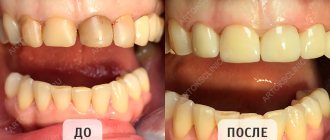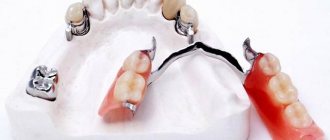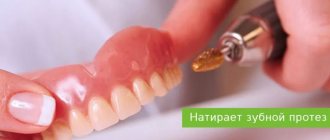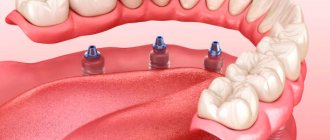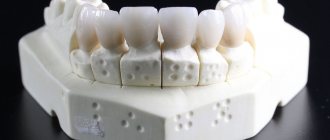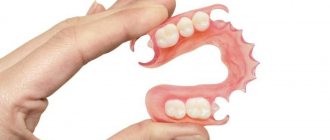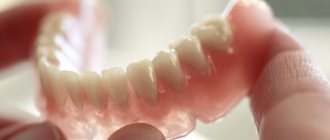The loss of one or two teeth is a reason to immediately make an appointment with a doctor who will help restore the unity of the row. Orthopedic and surgical dentistry offer many ways to solve this problem. The best of them is implantation, but it is not always possible to use it. Fixed bridge structures, which require grinding down the teeth adjacent to the defect, are not acceptable to everyone. But in such a situation, there is another remedy - the new generation “Butterfly” dentures. These structures can be produced as quickly as possible and installed immediately after the removal of any unit, while maintaining the integrity of the adjacent teeth.
Butterfly denture – why is it called that?
The butterfly denture got its name due to the similarity of its soft base to the wings of a butterfly. Of course, such similarity can be called conditional, since the shape of the prosthesis depends on the number of artificial teeth and the length of the supporting part. With a large loss of teeth in one jaw, the design turns into a clasp prosthesis on attachments and no longer resembles a butterfly: this is why it is customary to call only mini-prostheses for replacing one or two teeth.
The butterfly prosthesis is fixed in the mouth using clasps - special hooks that extend from the base of the structure: they are usually made of soft transparent plastic and tightly grip the supporting teeth.
How many implants are needed if there are no teeth?
To create a stable support for a removable denture with complete edentia, it is recommended to install:
- on the lower jaw - 4 mini-implants
- on the upper jaw - 6 mini-implants
The difference in quantity is due to the physiologically lower density of the maxillary bone.
Installing a smaller quantity will lead to improper load distribution and failure of the structure.
In order to reduce the cost of treatment, some clinics also install two mini-implants under a full-fledged prosthesis. They are installed in the anterior section, and the chewing areas remain without any fixation. But this is not the best option. When chewing, the denture will move and create a lever effect on the implants. It is easy to guess that the structure will fail very quickly. The initial savings will result in even greater costs in the future.
Chashchin Kirill Valerievich
Orthopedic dentist
14 years of experience
Virtuoso of prosthetics on implants. Competent planning and diagnostics, creation of comfortable prostheses taking into account individual parameters.
More about the doctor
When is a removable butterfly denture suitable?
As already mentioned, a removable butterfly denture is installed when it is necessary to replace one or two teeth. Most often this occurs after the implantation procedure, when it is necessary to replace the empty space while the implant is healing. First of all, this concerns the frontal zone, where aesthetics are important (do not walk around with a gaping hole instead of a front incisor). A butterfly denture for the front tooth is considered one of the most common removable structures when performing implantation in the aesthetic zone, but one should not think that when restoring molars and premolars, a temporary butterfly denture is not needed at all. The fact is that the loss of even one tooth seriously affects the functioning of the entire dentofacial apparatus. Firstly, the chewing load is not distributed correctly, which can lead to problems with bite and gastrointestinal tract (due to poor chewing of food). Secondly, neighboring teeth begin to shift to fill the missing space, so in the absence of a replacement prosthesis, the entire dentition slowly shifts, which can subsequently seriously complicate treatment. A butterfly partial denture solves these problems.
The only thing that such a prosthesis will not save from is bone tissue atrophy, which begins to occur after tooth extraction, but this problem is solved after the implantation of a titanium implant.
Principle of technology
Small implants, smaller models of classic ones, are used as support for a complete removable denture. Their diameter is only 1.8-2.4 mm, and their length is 6-10 mm. They are installed in an atraumatic way - by puncturing the gums, without extensive incisions. Removable prosthetics on mini-implants are carried out even in conditions of jaw bone atrophy - the height and density of bone tissue does not matter, there is no need to build it up.
Immediately on the day of implantation, a removable prosthesis is fixed onto the heads of the implants protruding above the gum , which combines the implants into one system . On the inner surface of each implant there are recesses with metal holders and silicone rings (support points). The fastening mechanism holds the structure and evenly distributes the load between the implants and the prosthesis itself. As a result, the bone tissue is “in working condition,” which stops bone atrophy (loss).
Prosthesis on mini-implants
Installation of a removable denture supported by mini-implants is an express procedure. Installation of implants takes up to 30 minutes depending on their number - 5 minutes for each. Digital impressions are immediately taken and sent to the laboratory. After 2-3 hours, the finished prosthesis is fixed.
Pros and cons of butterfly dentures
The quality of a butterfly prosthesis directly depends on its material and the professionalism of the specialists who will install this structure. In general, a temporary butterfly prosthesis has two key advantages, due to which this design has been widely used in dentistry for a long time.
- Replacement of the chewing function of the tooth. It is better not to subject a removable denture to heavy loads, but it copes quite well with chewing regular food.
- Not bad aesthetics. Modern designs (especially the nylon butterfly prosthesis) provide a very decent aesthetic result. When using transparent clasps, the butterfly prosthesis will not be visible on the gums.
However, it should be understood that a complete tooth replacement cannot be carried out using this type of prosthesis. The butterfly prosthesis also has a number of disadvantages that many patients have to put up with while wearing it. All the pros and cons of this type of prosthetics are outlined in the table below.
- No grinding of teeth.
To install a butterfly denture, you do not need to grind down adjacent teeth. - Easy care.
The structure must be washed with running water and cleaned with a brush, and placed in a special solution overnight. - Low cost.
We will tell you more about how much a butterfly prosthesis costs below.
- Difficulties with adaptation.
Immediately after installation of a butterfly prosthesis, problems with diction and discomfort when biting may occur. - Fragility.
This prosthesis breaks quite easily and does not have a long service life. - Allergic reaction.
When installing dentures made of acrylic and plastic, allergic reactions are possible.
Care
The structure does not require any special care; the following will suffice:
- after eating, rinse the butterfly with water, which will help remove food residues;
- Use toothpaste 2 times/day;
- To store the system, it is better to use a special solution, which is also used for conventional removable dentures.
Compliance with these simple rules will allow you to maintain the aesthetic appearance of the structure for a long time.
The cost of the structure will depend on the material used and the number of teeth that require restoration. For example, one unit of a system made using plastic costs 3–5 thousand rubles. If nylon is used to make a prosthesis, then the price will jump. In different clinics it can vary from 10 to 22 thousand rubles.
Sources used:
- Carr, Alan (2016). McCracken's Removable Partial Prosthodontics
- Agafonov A. Dental prosthetics: features
- Complications during dental prosthetics and their prevention / M.G. Bhushan, H.A. Kalamkarov. — M.: Shtintsa
Removable butterfly prosthesis – price in Moscow
The price of a butterfly denture, like all structures of this type, is not fixed. The cheapest samples cost an average of 3,000 – 5,000 rubles, but they are not always of high quality, which significantly affects the patient’s comfort. Budget prostheses are usually made of fairly hard plastic, which does not look very aesthetically pleasing and can also cause discomfort and even pain when worn. The price of a removable butterfly prosthesis made of nylon in Moscow dentistry will be more expensive (from 12,000 to 20,000 rubles for the most modern designs), however, from both a functional and aesthetic point of view, such systems are much more effective.
Dental prosthetics at the President clinic
Do you want to get a prosthesis, but are you afraid of pain? At the President clinic, prosthetics are done quickly and completely painlessly!
More than a million people have become our patients, and here's why:
- modern techniques and materials;
- specialists of the highest category;
- innovative equipment;
- personalized approach;
- physical and psychological comfort during procedures;
- several anesthesia options;
- convenient location - branches in all districts of Moscow.
Don’t put off your health for later, call right now to make an appointment and restore lost teeth in just a few days!
Everything you need to know about the shortcomings
The device is removable, so if you want to use it not as a temporary device, but as a permanent one (more than 1 year), the patient may encounter a number of problems. These include stretching and deformation of the material, grinding down of the plastic crown and disruption of occlusion, the risk of the structure falling out of the mouth, and the need to use special glue for better fixation (for example, Coregi). The prosthesis rests on supporting elements, and therefore they are subjected to double load and can quickly collapse.
If you have received a device, and you want its original appearance and convenience to be preserved for as long as possible, then you need to stop eating solid food and all those products that can lead to coloration of the material (strong coffee and tea, red wine, sauces, berries , pomegranate, beets). Remember that the device does not allow you to fully chew food. When you try to eat something hard, it quickly becomes deformed, and also begins to injure and rub your gums.
MANUFACTURING PROCEDURE
In order to provide the patient with maximum comfort and convenience when wearing the prosthesis, the design is made as follows:
At the initial stage, an impression of the patient’s jaw is taken. If the tooth is to be removed, the procedure is applied immediately before the operation. If a tooth is missing for a long period of time, an impression of the cavity is taken.
Next, using these casts, the crown of the missing tooth and fastenings are made. The materials used for this purpose are plastic, nylon, and metal alloys.
After the microprosthesis is manufactured, an initial fitting is performed on the patient. If discomfort occurs, additional polishing of the product is performed.
Purpose of the temporary apparatus
A false tooth “butterfly” solves a number of problems at once:
- restores the aesthetics of the smile and allows the patient to lead an active social life while the tissue heals and a permanent structure is made,
- quickly created - in 1-2 days. If the decision to make a prosthesis was made at the stage of preparation for removal, and the dentistry has its own laboratory, as well as modern equipment, then in general you can leave the clinic without a “gap” in your smile on the day of removal,
- stabilizes the position of the teeth that are located on the sides of the lost one: the likelihood of their loosening, displacement and curvature is eliminated,
- protects mucous membranes, soft tissues and wounds after removal from injury and infection.
Functional studies - for correct bite
Determination of jaw closure in the absence of teeth is impossible without a facebow and an articulator SAM3, Protar or Amann Girrbach.
- Creating a prosthesis taking into account the correct interaction of the jaws
- Prevention of temporomandibular joint dysfunction
